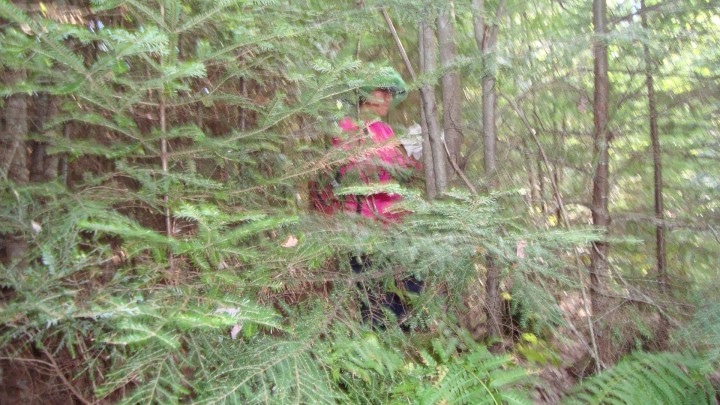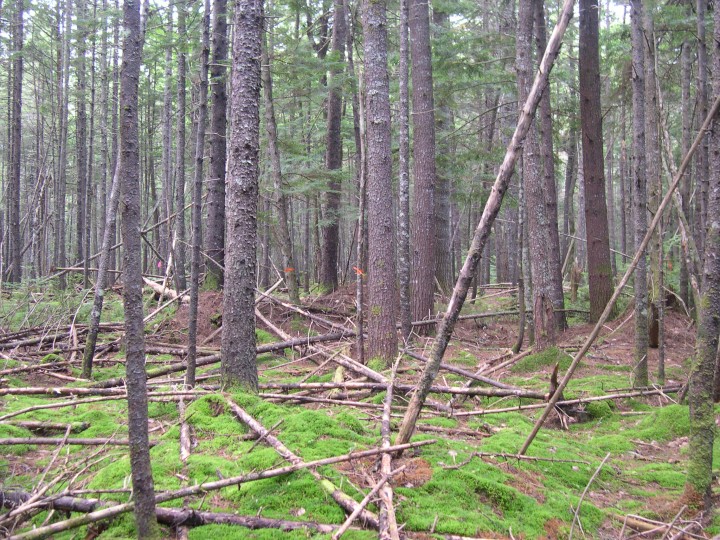Penobscot Experimental Forest
Temp: 91 °F (record 92 °F, 1987; average 78 °F) Humidity: 51 % Wind Speed 14 MPH Partly Cloudy
From Dr. Jon Ranson:
I’m a tired puppy right now. We started early today and put in a long, long day. We got a lot of measurements done. It’s delightful to be here and we are making good progress towards our goals.
The forest is very beautiful and also very diverse, with a lot of different species and a variety of sizes of trees. Even the understory is diverse. In some areas we have open, mossy ground to walk on. In others we push through scrubby undergrowth and other places its wet enough that you can sink into muck up to your ankles.

It’s another hot day – a near record high, I’m told. It feels just like my home in Maryland – hot and humid. The local news stations are urging people to stay inside because of the heat. Well, we don’t have the choice. We need to work, but we take our time, work slowly and drink a lot of water, so we’ll be fine. I keep telling myself to be grateful that it’s too hot for the local mosquitoes, too.
I heard from Dr. Saatchi at the Howland site that they had a bit of a challenge. They began the day by laying out their plot. They started at one end of the plot, locating the corners by GPS and putting down poly rope on the perimeter. When they arrived at the other end, they discovered that their plot was right across a road. We don’t get a huge amount of traffic here, but we’re interested in measuring forest, not roads, so this just wasn’t going to work. He ended up having to shift the plot 100 meters, resetting all the ropes. It took some time, but once they finished laying out the plot, they moved forward quickly with the measurements.

Today I was thinking about how different the forests really are, between here and my last field work in Siberia. The Siberian forests were almost uniformly larch, with little diversity. So one of our studies was about the larch itself. We wanted to see if the temperature increase affected the growth patterns of that species. In Maine, the forests are much more complex. There are many species, but there’s no larch. They say that at one time the paper companies tried to introduce larch here, for commercial use, but that it just didn’t grow well. There are a few larch trees in Howland, I’m told, but all were introduced and are not thriving.
In Siberia, the forests were extremely remote. We’d go days without seeing another person or even a sign of humanity. Here, of course, there are roads and civilization and we go back and get a hot shower every evening. I’m trying to imagine camping, running rivers and not being able to be really clean for two weeks while working like we are – and I find it hard to believe that I actually have done that. Yeah, of course I’ll do it again, but at this moment having a bed seems to make much more sense.
One other difference is that in Siberia, the most common type of forest disturbance is fire, but in Maine it is harvesting. The Penobscot forest is managed by what they call shelter wood cutting. This means that when the wood is to be cut, they run a machine through the forest that selects a certain amount of trees, but leaves most of the trees standing. After cutting, it still looks like a forest rather than a field of stumps or scraggly rejects. Since a lot of the forest in the Northeast is managed this way, it’s an excellent representation of what we will measure from space in this region.
This is something we need to be aware of, as scientists – managed forests can affect our remote sensing readings. If trees are removed, then there is less forest cover, and that has an effect on the wave form return that we get from lidar. The tree height is still the same, but the density is lower. If we were measuring biomass purely on the basis of height then the forest reading would look the same both before and after shelter wood cutting, because the height would still be the same. But the biomass would be vastly different. Lidar is able to penetrate the canopy of the forest, and returns a waveform that shows us that the density is different. Having the opportunity to measure these managed forests really helps us improve our instrumentation for biomass estimates.
I want to close by saying again: it’s great to be back in the woods. I’ve spent a lot of time in Maine in my career, and I just love it. It’s so great to get reacquainted with the hemlock and the balsam fir, both species I don’t see in Siberia or at home. The balsam fir is particularly nice. When you measure it, sometimes you get resin on your hands. Rather than being annoyingly sticky, it smells so good that you don’t mind. It’s a bit like natural aromatherapy – and one of the joys of working in Maine.




I am enjoying your blog. We, too, love the Penobscot Experimental Foerst (PEF). Fieldwork there is always an adventure! Readers interested in more information can find it at U.S. Forest Service websites, and in a number of publications. The PEF is one of 81 experimental forests in a nationwide network that dates back more than 100 years.
Best wishes,
Laura Kenefic
Principal Silviculturist (PEF) and representative to National Experimental Forest and Range Working Group